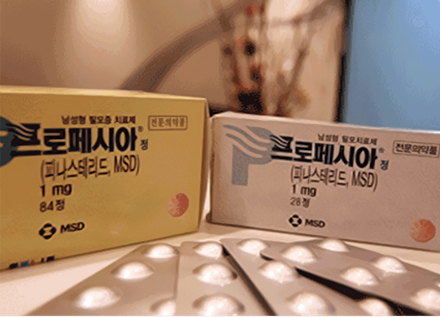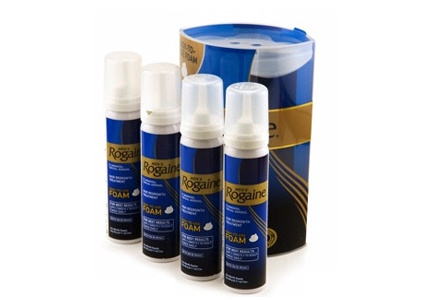Prescription drug treatment
that is suitable to one’s condition
It is recommended that you learn
about the drugs through sufficient consultation
with a specialist, and choose an appropriate treatment.
Drug Treatment
It sounds fascinating to see an advertising copy for hair loss treatments and hair loss treatment shampoos and creams. You may think your hair will start growing once you use it repeatedly, but, unfortunately, the only medicine that can treat your hair loss is through taking prescription drugs. The three certified drugs include Finasteride (Propecia), Dutasteride (Avodart), and Minoxidil. These drugs significantly slow down the progression of hair loss, and prevent hair from thinning. It is recommended that you study the effects and the side effects of these drugs through sufficient consultation with a specialist before taking a drug and choosing an appropriate treatment.
At NHI New Hair, a drug is prescribed as long as the patient wants, unless the patient has a specific reaction to it and administration of the drug must be stopped.

Drug Treatment / Finasteride
Preventing the conversion of testosterone to dihydrotestosterone (DHT), which causes male pattern hair loss
Suppressing the activity of 5aR reductase, which is enriched around the hair follicles among hereditary hair loss patients
Due to the two above-mentioned effects, 90% of patients who took this drug for 5 years experienced discontinuation of hair loss in some parts, while half of the patients observed new hair growth.
On the contrary, 75% of the patients who did not take the drug continued to experience hair loss during the study.
Propecia slightly alleviated hair loss, especially at the top, by 30%, showing a slight improvement in 31% of patients, and a significant improvement in 5% of patients. However, in the case of hair around the forehead, a slight improvement was shown in 38% of the patients, moderate improvement in 4% of the patients, and no significant improvement among all patients. Thus, Propecia can effectively protect the hair at the top, while it is not as effective in preventing hair loss at the hairline. It is considered good fortune that Propecia can protect the top area, to which hair transplant is relatively difficult to administer.

How to Take Finasteride
Taking Propecia, the pioneer drug
Propecia has been verified by numerous studies to date, since Finasteride began to be used as a form of hair loss treatment. It is the most effective way to take Finasteride 1mg, though it is more expensive compared to similar drugs due to its originality.
Taking a copy (generic) drug
Many generic drugs, including Monad tab., are sold with Finasteride 1mg. Since the drugs have the same ingredient as Propecia, which is effective in addressing hereditary hair loss, they can be considered as having the same effect.
Taking a fourth of Proscar
This is the cheapest way to take Finasteride. Since Proscar is a drug that can treat prostate disease, it contains Finasteride 5mg, so it should be taken by dividing it into 4 to 5 portions, instead of taking it all at once

- Method
Taking propecia, the pioneer drug
Taking a copy (generic) drug
Taking a fourth of proscar
- Ingredient
Finasteride 1mg
Finasteride 1mg
Finasteride 5mg
- Cost(Cost varies,depending on the region)
KRW 60,000 – 65,000 monthly
KRW 40,000 – 45,000 monthly
KRW 15,000 monthly

Drug Treatment / Dutasteride
In 2002, the FDA-approved drug called Avodart, a treatment for male prostate hypertrophy, also inhibited DHT production, and was effective in alleviating hereditary hair loss. This ingredient has not yet been studied thoroughly to obtain approval as a hair loss treatment. Although it is not yet approved by the FDA as a form of hair loss treatment, it is sold under the name of "Avodart" with KFDA approval. In case there is no effect after taking Propecia for at least 6 months, Avodart is prescribed with the consent of the patient. Its efficacy and side effects, however, must be fully disclosed and understood.
Effect of Dutasteride
Like Finasteride (Propecia), Dutasteride (Avodart) also inhibits the conversion of testosterone to DHT by interfering with the action of enzyme 5AR. However, while Propecia blocks only one type of enzyme, Avodart blocks two types of enzymes, resulting in higher efficacy and a wider range of side effects. A dose of 0.5 mg of Dutasteride per day reduces DHT by 91% in the blood, and by 54% in the scalp. Finasteride, on the other hand, reduces DHT by 71% in the blood, and by 38% in the scalp. Just by looking at these figures, is it possible to tell which of these two drugs is effective in stopping hereditary hair loss? So far, 17 pairs of identical twins have been tested, and Dutasteride has been found to be effective in treating hair loss among 15 pairs of identical twins. Moreover, a study comparing Dutasteride and Finasteride was conducted on 416 men for 24 weeks. However, more research must be performed to determine how effective it is in hair loss treatment, and to identify its side effects.
Concern about the Side Effects of Dutasteride
Dutasteride has more sexual side effects than Propecia. During the first 6 months of taking this drug, impotence was observed in 4.7% of patients, while diminished sexual drive, ejaculatory disturbance, gynecomastia, and breast tenderness have been reported. The incidence of several side effects gradually lessened as the experiment continued, but breast tenderness and enlargement persisted throughout the treatment period. A recent study reported that Dutasteride significantly reduced sperm count, and pregnant women should not even touch the drug because the drug can also be absorbed through the skin. It also has a longer retention in the blood than Finasteride, and the drug can be detected in the blood for up to half a year after stopping to take it. While Propecia is a therapeutic drug that blocks only one isozyme, Avodart blocks two enzymes. Due to an unavoidable loss caused by this blockage, there is concern about side effects. Still, we recommend to the patient to try it if the patient has not been satisfied with Propecia.

Drug Treatment / Minoxidil
Minoxidil is the only drug approved by the FDA as a hair loss treatment. There are two types of Minoxidil, one for women and one for men. However, there may be a side effect, such as thickening of hair on the face during use. In case you experience such symptom, it will stop once you stop using the drug. The representative drug of Minoxidil is 'Rogaine', and its generic counterparts include Minoxyl, Scalp Med, Nanoxidil, Moxidil, and Mydil solution. The Rogaine foam is the simplest product, but it can only be availed through purchase in overseas shopping malls. It is okay to purchase a copy (generic) drug at a nearby pharmacy.

How to Apply Minoxidil
There are several types of Minoxidil, depending on the manufacturer, including gel type, spray type, and liquid type. Depending on how it is made, there is a difference in how it is applied, but it is best to apply it to reach the scalp as much as possible. If hair loss has progressed enough to require Minoxidil, the hair in the hair loss area is thin and the density of the hair is low, so do not worry about what will happen if Minoxidil is absorbed by the hair while it is applied, thereby lessening its effect. The amount recommended by the manufacturer must be meticulously applied to reach the scalp.


















